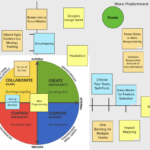Gemba Walk for Scrum Teams
Being involved with Scrum Masters and their teams is the best job on the planet. Few things are as satisfying as watching a Scrum Team become more adaptive, grow in confidence and shoulder responsibility as a cohesive unit. Although experiencing these improvements as they occur is amazing to witness, I’ve struggled to capture and quantify these developments. Enter the “Gemba Walk” for Scrum teams.

To occasionally introduce new managers to “Gemba Walks” I’ve read that Taiichi Ohno, the father of the Toyota Production System, would draw a circle on the floor next to the production line. He invited the new manager to stand in the circle. With instructions to note where improvements could be made, the faithful student would remain in place for hours. If upon Ohno’s return the list was too short, the manager may find himself standing in the same spot the next day. This would continue until a sufficient list of improvements was in hand. Over the past couple of months, I’ve been working on a tool that offers a similar view for potential Scrum improvements.
- Scrum Values
- Lean Wastes
- Understanding & Use of Scrum
- Discussion
- Observations
Gain a better idea of this outline by downloading the PDF example “Alpha Team Daily Standup”, that accompanies this post.
Scrum Values
Here are some questions I may ask myself while observing Scrum Values.
- Openness – Do team members share freely that they don’t understand something, are having trouble or need help?
- Focus – Is this a dedicated team? If not, assess how much this lack of focus hinders the team from reaching the Sprint goal.
- Courage – Do team members jump at the opportunity to learn something new?
- Commitment – Is the team ready to do what ever necessary to reach the Sprint goal? A couple of classic examples are developers helping test. Another is readiness to help when someone falls behind.
- Respect – Is the conversation between team members supportive, helping to develop a cohesive safe environment?
I express the team’s proficiency using the numbers 1 – 5. Five indicates the team has embraced the Scrum Value as part of their culture. One indicates serious struggles. Numbers in between express varying degrees of adoption.
Lean Wastes
- Muda (no value)
- Mura (flow)
- Muri (allocation)
- If the team finishes the Sprint goal, but the Product Owner has a heart attack during the review, we’ve have Muda. Don’t track only big problems. Also look for re-work or lost work.
- If the team’s conversation indicates problems with how work flows through the team, you have Mura. Look for “friction” in incoming work, in process work, or work being handed off to another team.
- Finally every time a team member works over time, you have Muri.
Understanding & Use of Scrum
Look for improvements in the Scrum implementation. Here we examine how well the three Scrum Roles are understood and applied. We likewise observe the extent to which the development team is self-organizing and cross-functional. Scrum events, artifacts and pillars are also captured as they come up during the team’s conversation. As with the Scrum Values, these are also assigned a 1 – 5.
Discussion & Observations
Finally, context is created by capturing highlights from the discussion and noting observations. Anything that supports the numerical score is highlighted in bold. This context gives specific examples the team can easily identify and use to underscore the need for improvement. This does away with remembering half forgotten conversations and guessing about what actually happened.
This model supporting “Gemba Walks” for Scrum Teams has drastically improved the quality of my conversations. Keep in mind, the goal of any “Gemba Walk” is not to assign grades. But to capture impressions that guide conversations leading to incremental improvements.

